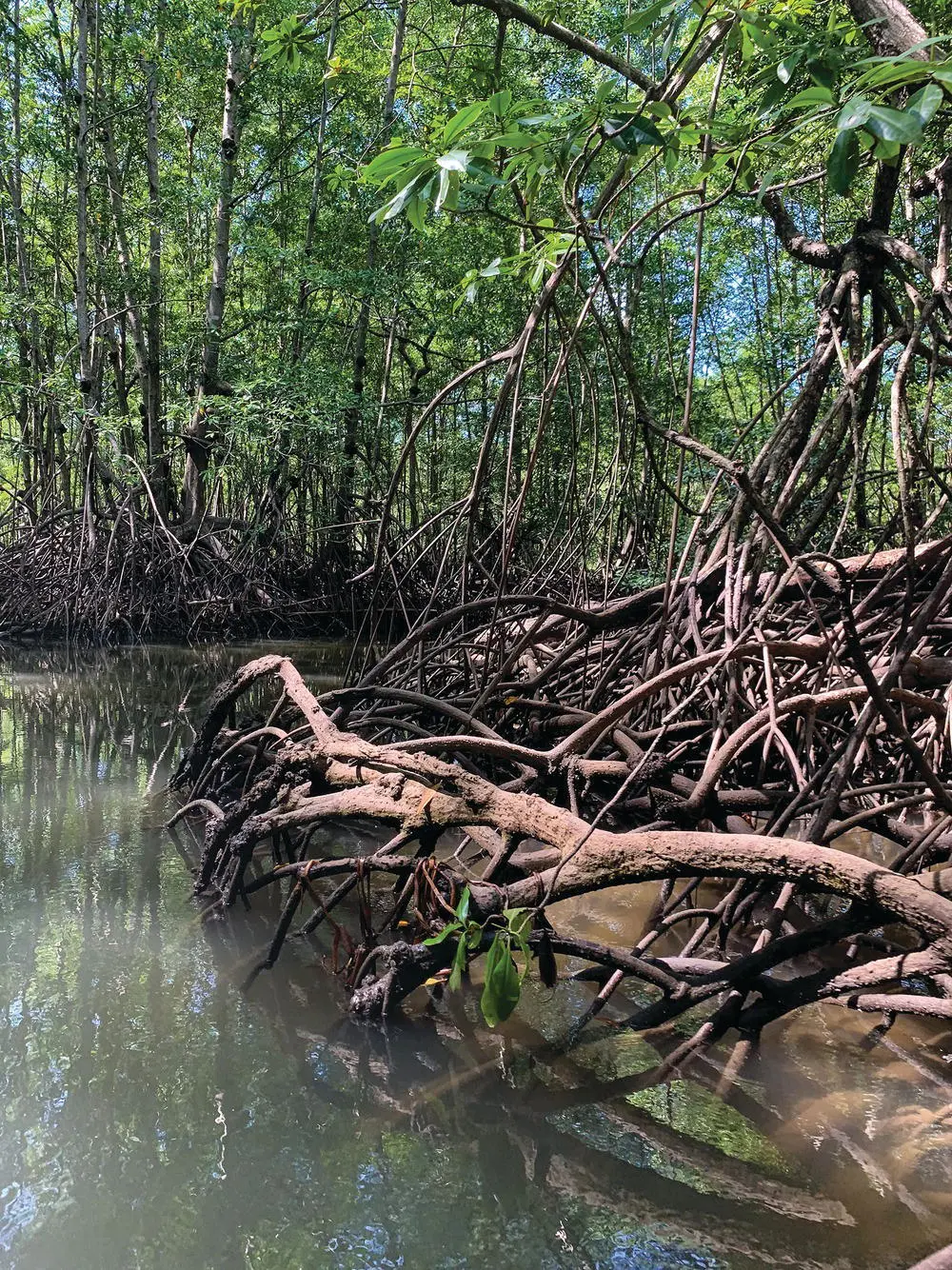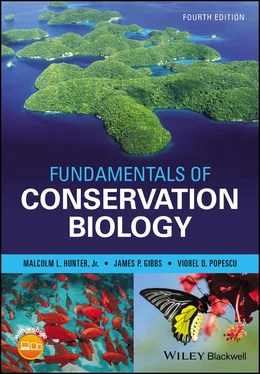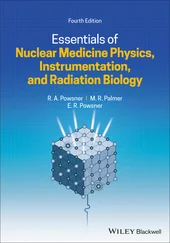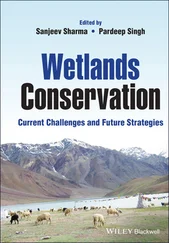(Drew Tarvin/Flickr/CC BY 2.0)
Conservation biologists are interested in landscape phenomena for a number of reasons that we will examine further in subsequent chapters. Two brief examples will suffice here. First, many endangered species are large animals that have large home ranges – tigers, wolves, elephants, etc. – that encompass many ecosystems. If we wish to maintain habitat for these species, we must maintain entire landscapes that provide for all their needs. Second, human activities have left many natural ecosystems as islands, isolated in a “sea” of human‐altered ecosystems, and conservation biologists are concerned with what happens along the edges of these small, residual patches. Are they being degraded by factors that originate externally such as exotic species, pesticides, and changes in local climate?
These and similar issues have led conservation biologists to advocate maintaining biodiversity from a landscape perspective (Groves and Game 2016). This is a way of saying that it is not sufficient to protect a representative array of ecosystems. We must also ensure that these ecosystems are arranged spatially so as to maintain the natural relationships among them. In short, to conserve biological diversity we should maintain natural, functioning landscapes composed of many interacting ecosystems.
CASE STUDY 4.1 Mangrove Swamps
Tropical shores are not all white‐sand beaches lined by coconut palms. In many places the land–sea transition is marked by dense stands of trees and shrubs that form mangrove swamps or mangal ( Fig. 4.12). The seaward edge of a mangrove swamp is usually sharply delineated, but moving inland it often grades into other types of swamps as the elevation rises and the water becomes less saline. This gradation is one reason why the term “mangrove” is rather ambiguous. “Mangrove” is a quasi‐taxonomic term that can be used for at least 70 species of woody plants from 11 families that inhabit tropical intertidal environments (Wang et al. 2003). Depending on the range of salinities you choose to include, many more species could be added. Of course, on a global scale 70 species is not very many and in any given mangrove swamp only one or a few species of mangrove may occur.

Figure 4.12 Mangroves are marine wetlands that occur along many tropical coastlines.
(William Warby/Flickr/CC BY 2.0)
Despite modest levels of plant species diversity, mangrove swamps are important and interesting ecosystems (Kathiresan and Bingham 2001 ; Nagelkerken et al. 2008; Feller et al. 2010). First, they are extremely productive, capturing sunlight and collecting nutrients imported by the tides, and exporting huge amounts of organic matter to the adjacent aquatic ecosystems where they support aquatic food webs and economically valuable fisheries. For some fish species, mangrove swamps are often called nurseries because they provide food and cover for young individuals (Paillon et al. 2014). They also provide a sort of cover for shoreline human communities by creating a buffer against ocean storms and tsunamis. Conversely, they buffer coral‐reef and sea‐grass ecosystems from siltation stemming from inland erosion. Mangrove swamps also provide resources – timber and fuelwood – that sometimes, unfortunately, lead to their overexploitation. Worse than the threat of excessive timber harvesting is the wholesale destruction of mangrove swamps to make room for aquaculture (notably for shrimp production ponds), agriculture, and coastal development (ranging from garbage dumps to high‐rise hotels). Because they occupy a narrow band between the land and the sea, mangrove swamps have never occupied a large total area, and this makes it doubly tragic that so many have been lost. Worldwide, a substantial portion of mangroves have been destroyed, probably leaving far less than 200,000 km 2(Sandilyan and Kathiresan 2012 ; Webb and Friess 2014). This seems particularly short‐sighted given economic studies like one from India that estimated local income of $753/ha/year from natural products tied to mangroves versus $438 from mangroves converted to rice paddies (Chauhan et al. 2017). The mangroves’ value soared to over $5000/ha/year if you add more speculative values such as protection from storms and carbon sequestration.
The conceptual definition of an ecosystem is straightforward – a group of interacting organisms and their physical environment – but deciding where one ecosystem ends and another begins can be difficult. Evaluating the differences and similarities among many ecosystems and classifying them into different ecosystem types is even more challenging. Despite these difficulties, recognizing and classifying ecosystems are useful exercises for organizing our understanding of the patterns of ecological interactions.
The value of an ecosystem, at a minimum, consists of the sum of all the values of the species that occupy the ecosystem. Beyond this, the instrumental values of ecosystems are primarily based on services: for example, exporting clean water and other economically valuable functions, providing complex models for research and education, and serving as sites for spiritual renewal. Ecosystems have a critical strategic role in conservation because protecting a representative array of ecosystems will protect biodiversity at the species and genetic level to a significant extent. The idea of ecosystems having intrinsic value revolves around an unresolved controversy: to what extent are ecosystems loosely organized collections of species versus highly integrated systems of coevolved species? The closer they are to being highly integrated, the more likely it is that loss of species could lead to ecosystem degradation. In general, ecosystems with high species diversity are likely to be less subject to degradation (more stable), but this is a complex subject. Many factors influence the relative species diversity of different types of ecosystems such as patterns of energy, water, heterogeneity, size, and more. Maintaining ecosystem diversity also requires maintaining the spatial arrangements in which ecosystems occur; in other words, natural landscapes require protection.
A 29‐volume series, Ecosystems of the World, published by Elsevier of Amsterdam, is the single most comprehensive treatment available. The Millennium Ecosystem Assessment (millenniumassessment.org) reported on the status of the world’s ecosystems and the services they provide, as well as the basis for conserving them. See cices.eu for a classification of ecosystem services developed by the European Environment Agency. Turner and Gardiner (2015) provide a comprehensive perspective on ecosystems as elements in landscapes, and Groves and Game (2016) cover conservation planning, particularly at that scale. For web‐based information about ecological communities in the western hemisphere, including a classification system, see www.natureserve.org. You can use https://www.worldwildlife.org/biomesto learn more about hundreds of ecoregions, organized by 26 major types across seven biogeographic realms.
1 In the area where you live, develop a list of 10 types of ecosystems (natural and human‐created). Which types of ecosystems were easiest to define? Which were hardest? Why?
2 Draw a map of the ecological region you inhabit. How did you distinguish it from surrounding regions?
3 What is the rarest type of ecosystem in your region? Have many examples of it been protected?
4 What services are provided by the major types of ecosystems in your region?
Читать дальше













